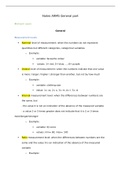Notes ARMS General part
Mid-term exam
General
Measurement levels
Nominal level of measurement: when the numbers do not represent
quantities but different categories, categorical variables.
o Example:
variable: favourite colour
values: 1= red, 2= blue, ..., 6= purple
Ordinal level of measurement: when the numbers indicate that one value
is more / larger / higher / stronger than another, but not by how much
o Example:
variable: clothing size
Value: 1= xs, 2= s, 3= m, 4= l, 5= xl
Interval measurement level: when the differences between numbers are
the same, but
- the value 0 is not an indication of the absence of the measured variable
- a value 2 or 3 times greater does not indicate that it is 2 or 3 times
more/longer/stronger
o Example:
variable: IQ score
values: min= 60, max= 140
Ratio measurement level: when the differences between numbers are the
same and the value 0 is an indication of the absence of the measured
variable
o Example:
, variable: body height of the participant
values: between 80 and 210 cm
Lectures
Lecture 1
Simple linear regression > involves 1 outcome (Y) and 1 predictor (X).
Outcome = DV = dependent variable (= e.g. IQ)
Predictor = IV = independent variable (= e.g. Birth order)
yi = bo + b1Xi + ei
Multiple linear regression > involves 1 outcome and multiple predictors
yi = bo + b1Xi + b2X2i + b3X3i + ei
The relevance of a predictor:
R2 = the amount of variance explained (i.e. the sizes of the residuals)
b1 = the slope of the regression line (regression coefficient)
, A. The model
yi = b0 + b1X1i + b2X2i + ei
b0 = intercept
b1X1i = slope of x1
b2X2i = slope of x2
ei = residual
Observed outcome is a prediction based on the model and some error in the
prediction > yi = ^yi + ei
ei is the error in the prediction and is different for everyone. The i stands for
variables where people vary on. The terms without the i is a summary over a
whole group. The relation between X1 and y is b1.
Additive linear model > assumed is that the effects of each predictor is additive.
^yi = b0 + b1X1i + b2X2i
B. Types of variables
Formal distinction in 4 measurement levels
Nominal
Ordinal
Interval
Ratio
, For choice of analysis distinguish
Nominal + Ordinal > categorical/qualitative
Interval + Ratio > continuous/quantitative/numerical
MLR requires continuous outcome and continuous predictors
But categorical predictors can be included as dummy (D) variables
(variable with only two values (0 and 1), e.g. male (0) and female (1). Clear
interpretation.
Grade = B0 + B1*Dfemale.i
Grade male = B0
Grade female = B0 + B1
B1 is the difference in prediction between male and female.
Categorical predictors with more than 2 levels, e.g. variable colour >
create multiple dummys > red/not, blue/not, green/not, yellow as
reference (B0)
^yi = b0 + b1Redi + b2Bluei + b3Greeni (NOT ^yi = b0 + b1Colouri)
C. MLR and hierarchical MLR
Research question 1: Can Life Satisfaction be predicted from age (x 1) and years
of education (x2).
Research question 2: Are social network factors (as measured by child support
(x3) and spouse support (x4) improving the prediction of Life Satisfaction, if the
effects of age and years of education are already accounted for.
Model 1: yi = b0 + biX1i +b2x2i + ei
Model 2: yi = b0 + b1X1i + b2X1i + b3X3i + b4X4i + ei
Hypotheses:






